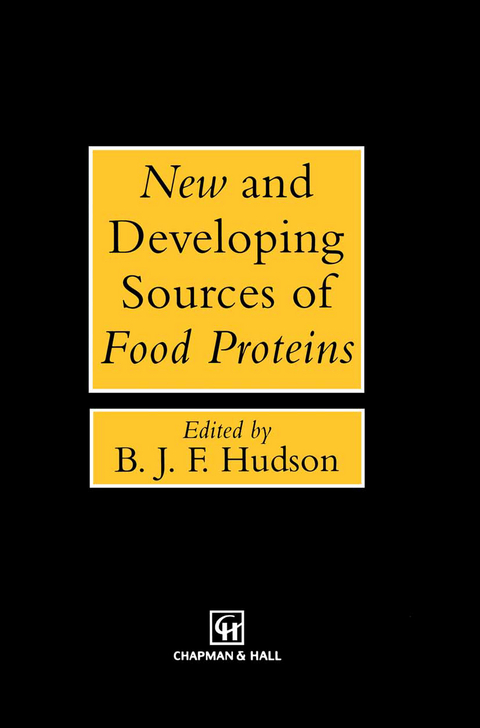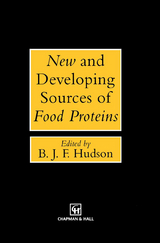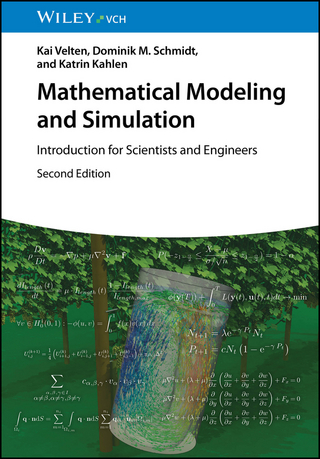New and Developing Sources of Food Proteins
Chapman and Hall (Verlag)
978-0-412-58420-6 (ISBN)
The recent series of texts 'Developments in Food Proteins' comprised in all seven volumes which were published in the course of the decade 1982-1991. Each volume contained inter alia one or more chapters that were concerned with new or developing sources of food proteins. Most of these have now been collected together in an up dated and re-evaluated form for the present volume. 'New' sources of food proteins includes those sources that are unconventional, that are still of very limited significance in market terms, or that are at present of very localized use. Several of these were included in 'Developments in Food Proteins'. One of them, algae, appeared both in Volume 1 and in an up-dated form in Volume 7. It is therefore not included here. Others, such as yeasts and bacteria, have not yet increased in practical importance as potential food components beyond the long-term promise already evident at that time. However, leaf protein, as described in the present Chapter 10, has moved from the original rather crude concept to a much more sophisticated product in the form of Rubisco. Fungal protein, as Quorn (Chapter 11), has also proved to be potentially of real food value. 'Developing' sources of food protein are those sources that have always been basic items in human diets.
1 Developments in the production of milk proteins.- 1.1 Casein.- 1.2 Whey proteins.- 1.3 Chemically, physically and enzymically modified milk proteins.- 1.4 Conclusions.- References.- 2 Food proteins from red meat by-products.- 2.1 Introduction.- 2.2 Edible proteins from bone.- 2.3 Edible proteins from hide, skin and connective tissue.- 2.4 Edible proteins from animal blood.- 2.5 Edible proteins from lung and stomach tissues.- 2.6 Conclusions.- References.- 3 Poultry — the versatile food.- 3.1 Introduction.- 3.2 Functionality of poultry muscle proteins.- 3.3 Mechanically recovered meat.- 3.4 Conclusions.- References.- 4 New product innovations from eggs.- 4.1 Introduction.- 4.2 Egg product innovations.- 4.3 Eggs in the food service industry.- 4.4 Cholesterol and fat-modified egg products.- 4.5 Snack egg products.- 4.6 Other opportunities and applications.- 4.7 Conclusions.- References.- 5 Fish protein.- 5.1 Introduction.- 5.2 Fish as food.- 5.3 The nature of fish flesh.- 5.4 Protein products.- 5.5 Current commercially viable protein products.- 5.6 Non-commercial processes and products.- 5.7 Conclusions.- References.- 6 Proteins of some legume seeds: soybean, pea, fababean and lupin.- 6.1 Introduction.- 6.2 Protein content.- 6.3 Major individual protein fractions.- 6.4 Use of legume seed proteins in food.- 6.5 Nutritional aspects.- 6.6 Conclusions.- References.- 7 Peanut and cottonseed proteins for food uses.- 7.1 Introduction.- 7.2 Peanuts.- 7.3 Peanut protein properties and uses.- 7.4 Cottonseed.- 7.5 Cottonseed protein properties and uses.- 7.6 Applications in foods.- References.- 8 Food proteins from emerging seed sources.- 8.1 Introduction.- 8.2 General description of cultivars.- 8.3 Seed properties and oil extraction.- 8.4 Composition of seeds and meals.- 8.5Protein concentrates and isolates.- 8.6 Solubility of fractions and physicochemical properties of proteins.- 8.7 Functional properties and nutritional value.- 8.8 Future prospects.- References.- 9 Rapeseed protein.- 9.1 Introduction.- 9.2 Composition and structure of rapeseed proteins.- 9.3 Functional properties of native and chemically modified rapeseed protein.- 9.4 Interactions of rapeseed proteins with non-protein seed compounds.- 9.5 Protein preparation and product properties.- 9.6 Concluding remarks.- References.- 10 Leaf protein for food use: potential of Rubisco.- 10.1 Introduction.- 10.2 Basic knowledge of Rubisco.- 10.3 Food technology of Rubisco.- References.- 11 Fungal protein.- 11.1 Single cell protein.- 11.2 Micro-fungi as a source of protein.- 11.3 Safety testing.- 11.4 Nutritional considerations.- 11.5 Other fungal protein products.- References.
| Erscheint lt. Verlag | 30.9.1994 |
|---|---|
| Zusatzinfo | XIII, 369 p. |
| Verlagsort | London |
| Sprache | englisch |
| Maße | 155 x 235 mm |
| Themenwelt | Naturwissenschaften ► Chemie |
| Technik ► Lebensmitteltechnologie | |
| ISBN-10 | 0-412-58420-4 / 0412584204 |
| ISBN-13 | 978-0-412-58420-6 / 9780412584206 |
| Zustand | Neuware |
| Haben Sie eine Frage zum Produkt? |
aus dem Bereich




